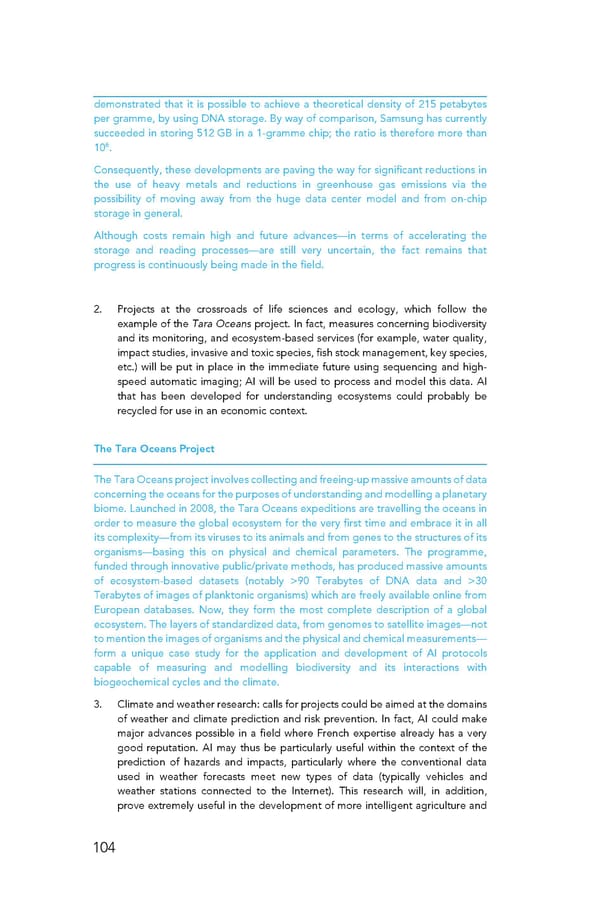demonstrated that it is possible to achieve a theoretical density of 215 petabytes per gramme, by using DNA storage. By way of comparison, Samsung has currently succeeded in storing 512 GB in a 1-gramme chip; the ratio is therefore more than 6 10 . Consequently, these developments are paving the way for significant reductions in the use of heavy metals and reductions in greenhouse gas emissions via the possibility of moving away from the huge data center model and from on-chip storage in general. Although costs remain high and future advances—in terms of accelerating the storage and reading processes—are still very uncertain, the fact remains that progress is continuously being made in the field. 2. Projects at the crossroads of life sciences and ecology, which follow the example of the Tara Oceans project. In fact, measures concerning biodiversity and its monitoring, and ecosystem-based services (for example, water quality, impact studies, invasive and toxic species, fish stock management, key species, etc.) will be put in place in the immediate future using sequencing and high- speed automatic imaging; AI will be used to process and model this data. AI that has been developed for understanding ecosystems could probably be recycled for use in an economic context. The Tara Oceans Project The Tara Oceans project involves collecting and freeing-up massive amounts of data concerning the oceans for the purposes of understanding and modelling a planetary biome. Launched in 2008, the Tara Oceans expeditions are travelling the oceans in order to measure the global ecosystem for the very first time and embrace it in all its complexity—from its viruses to its animals and from genes to the structures of its organisms—basing this on physical and chemical parameters. The programme, funded through innovative public/private methods, has produced massive amounts of ecosystem-based datasets (notably >90 Terabytes of DNA data and >30 Terabytes of images of planktonic organisms) which are freely available online from European databases. Now, they form the most complete description of a global ecosystem. The layers of standardized data, from genomes to satellite images—not to mention the images of organisms and the physical and chemical measurements— form a unique case study for the application and development of AI protocols capable of measuring and modelling biodiversity and its interactions with biogeochemical cycles and the climate. 3. Climate and weather research: calls for projects could be aimed at the domains of weather and climate prediction and risk prevention. In fact, AI could make major advances possible in a field where French expertise already has a very good reputation. AI may thus be particularly useful within the context of the prediction of hazards and impacts, particularly where the conventional data used in weather forecasts meet new types of data (typically vehicles and weather stations connected to the Internet). This research will, in addition, prove extremely useful in the development of more intelligent agriculture and 104
 For a Meaningful AI - Report Page 104 Page 106
For a Meaningful AI - Report Page 104 Page 106